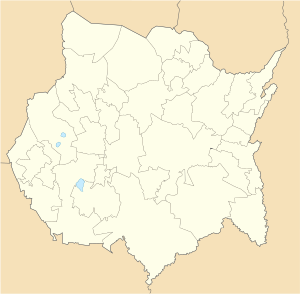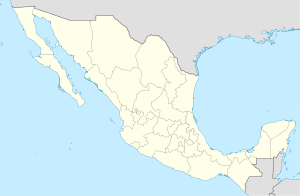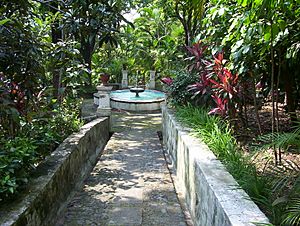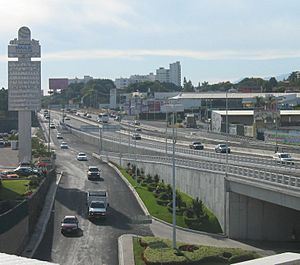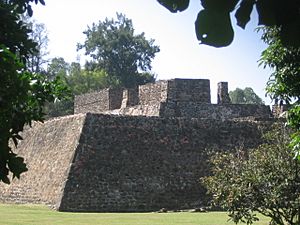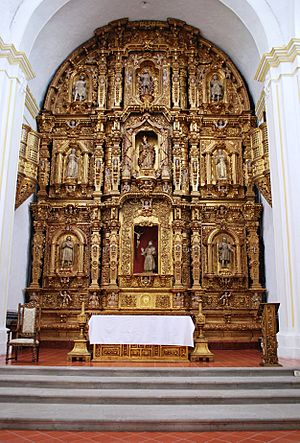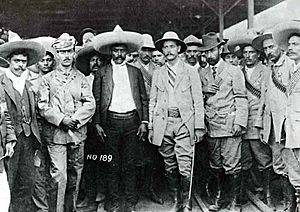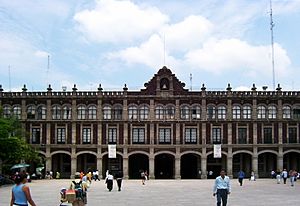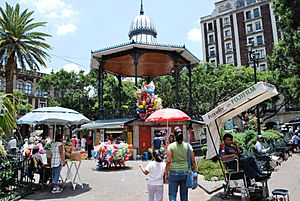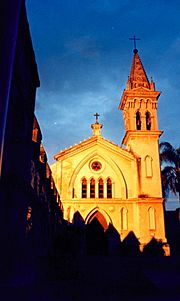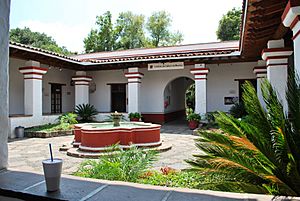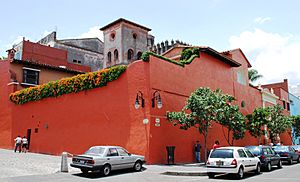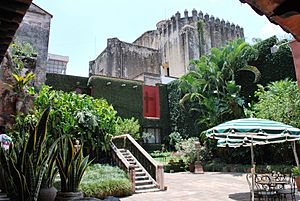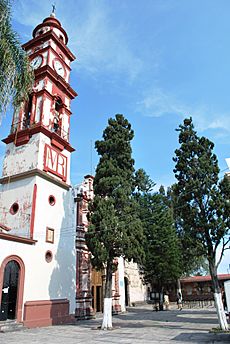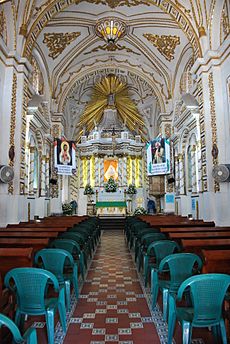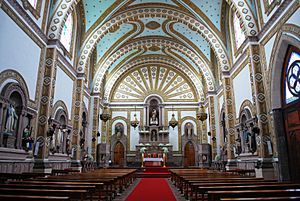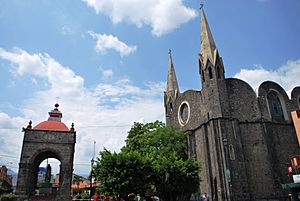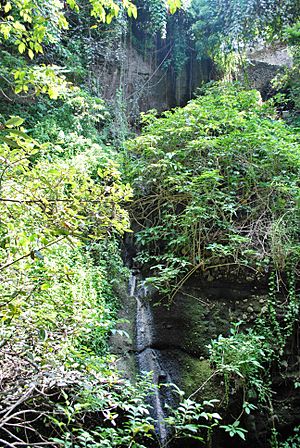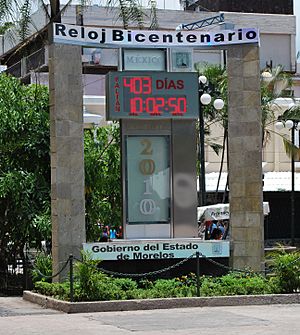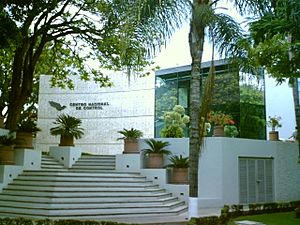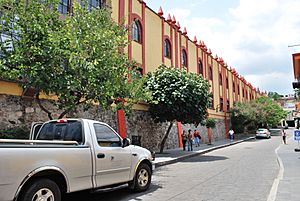Cuernavaca facts for kids
Quick facts for kids
Cuernavaca
Cuauhnāhuac
|
|||
|---|---|---|---|
|
City and Municipality
|
|||
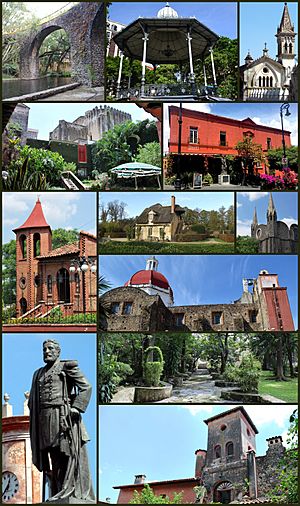
From top, left to right: Train bridge in the Chapultepec Ecological Park, Kiosk in Jardín Juárez, Chapel of Our Lady of Mount Carmel, Inner courtyard of the Robert Brady Museum, Restaurant Alondra (Historic Center), El Castillito, Side facade of the entrance to Villa Cuauhnáhuac, Chapitel del Calvario, View of the dome of the Parish of Our Lady of Guadalupe, General Carlos Pacheco Villalobos Monument, Borda Garden, Tower of the Robert Brady Museum
|
|||
|
|||
| Nickname(s):
"City of Eternal Spring"
|
|||
| Country | |||
| State | Morelos | ||
| Founded | 1714 | ||
| Municipal Status | 1821 | ||
| Area | |||
| • Municipality | 151.2 km2 (58.4 sq mi) | ||
| Elevation
(of seat)
|
1,510 m (4,950 ft) | ||
| Population
(2015) Municipality
|
|||
| • Municipality | 366,321 | ||
| • Seat | 332,197 | ||
| Time zone | UTC−6 (CST) | ||
| • Summer (DST) | UTC−5 (CDT) | ||
| Postal code (of seat) |
62000
|
||
| Area code(s) | 777 | ||
Cuernavaca is the capital and largest city of the state of Morelos in Mexico. It's about a 90-minute drive south of Mexico City. You can get there using the Federal Highway 95D.
The name Cuernavaca comes from the Nahuatl word Cuauhnāhuac. This means 'surrounded by or close to trees'. The Spanish changed the name to Cuernavaca. The city's symbol shows a tree trunk with three branches and four red roots. It also has a mouth-shaped cut with a speech scroll. This likely represents the Nahuatl language.
Cuernavaca has always been a favorite place for people to visit. It has a warm, stable climate and lots of plants. In 1937, the area became a Forest Protection Zone. This was to protect its water, plants, and the quality of life for people. In the 19th century, Alexander von Humboldt called it the "City of Eternal Spring".
Even Aztec emperors had summer homes here. Today, many Mexico City residents have homes in Cuernavaca. Many foreign students also come to Cuernavaca to learn Spanish.
Contents
- Discovering Cuernavaca City
- A Look Back: Cuernavaca's History
- Must-See Places in Cuernavaca
- Palace of Cortés: A Historic Building
- Morelos and Juárez Gardens: City Squares
- Cuernavaca Cathedral: A Historic Church
- Teopanzolco: Ancient Pyramids
- Borda Garden: A Royal Retreat
- Robert Brady Museum: Art from Around the World
- Tlaltenango: A Historic Neighborhood
- Hacienda Atlacomulco: An Old Sugar Plantation
- Museum of Traditional and Herbal Medicine
- Children's "Kite" Museum
- Chapultepec Ecological Park: Nature and Fun
- Chapitel del Calvario: A Church with Spire
- El Castillito: The Little Castle Museum
- Salto de San Antón / St. Anthony Waterfall
- Juan Soriano Museum of Contemporary Art
- Ravine of Amanalco Park
- La Tallera David Alfaro Siqueiros: Art and History
- Other Museums to Explore
- Parks and Fun Places
- Monuments: Statues and Landmarks
- Fun Festivals and Dances
- Understanding the Municipality of Cuernavaca
- Climate of Cuernavaca
- Cuernavaca's Economy
- Learning in Cuernavaca: Schools and Universities
- International Connections
- Transportation in Cuernavaca
- See also
Cuernavaca is known as the "City of Eternal Spring". This nickname came from Alexander von Humboldt in the 1800s. He wrote about the area's lovely, mild weather.
The city is in a tropical area. Its temperature stays pretty steady, usually between 70 and 79 degrees Fahrenheit (21 to 26 degrees Celsius). It sits on the southern side of the Sierra de Chichinautzin mountains. Warm air moves up from the valley in the mornings. Cooler air flows down from the mountains in the late afternoons. You'll see lots of beautiful bougainvillea flowers here.
This wonderful climate has drawn important people for centuries. Even Aztec rulers and later, foreign nobles, loved this place. They enjoyed its flowers, sunshine, fruits, and waterfalls. Emperor Maximilian I of Mexico had a country home here. Many famous people have also chosen Cuernavaca as their home.
Cuernavaca has always been a popular escape from Mexico City. In the 20th century, its climate also attracted many people from other countries. The city's population grew a lot starting in 1940. By the 1960s, it became a recognized metropolitan area.
The population and size of the area have continued to grow. From 1960 to 1980, the population jumped from 85,620 to 368,166 people. Today, the metropolitan area includes nearby towns like Emiliano Zapata, Jiutepec, Temixco, Tepoztlán, and Xochitepec. Most people and businesses are still in Cuernavaca city itself. In 2015, the metropolitan area had over 912,000 people. The city of Cuernavaca had about 366,000 residents.
Over the years, Cuernavaca has become more connected to Mexico City. Many people from Mexico City own second homes here for weekend trips. They enjoy the climate and good facilities. Starting in the 1980s, more people moved here permanently. This was partly due to problems in the capital. The 1985 Mexico City earthquake also caused many families to move here. This growth has helped Cuernavaca's economy. However, it has also put pressure on the city's services. Most of Cuernavaca is now used for housing.
Very old burial sites have been found in Gualupita, north of the city. They are about 3,000 years old.
The first main group of people here were the Tlahuica. Their main town was where Cuernavaca is now. The Tlahuicas have lived here since at least the 1100s.
In the 12th century, groups from the Valley of Mexico started moving south. A lord named Xolotl conquered much of the Valley of Mexico. A related tribe, the Chichimeca, moved into northern Morelos. They made Techintecuitla the ruler of the Cuauhnahuac area. The Tlahuicas lived in nearby towns. In 1365, the ruler of Cuauhnahuac, Macuilxochitl, tried to expand his lands.
The first Aztec emperor, Acamapichtli, began expanding his empire in the 1370s. His successor, Huitzilihuitl, wanted the cotton from this area. He tried to marry the local ruler's daughter but was refused. This led to a war, which the Aztecs won in 1396. Huitziliuitl then married the princess. Their son was Moctezuma I. The Aztecs renamed the conquered area Cuauhnahuac.
From 1403 to 1426, this area grew stronger. It took over nearby peoples. Later, the province rebelled against the Aztec Empire. This rebellion was stopped in 1433. The area then helped conquer other places. For taxes, the land was split into two parts. One was led by Cuauhnahuac.
Spanish Arrival and Early Days
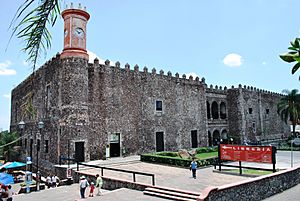
When the Spanish arrived, Itzohuatzin ruled Cuauhnahuac. It was a rich city with many people and large farms. It had bridges over its deep ravines. The Spanish marched on Cuernavaca even before taking the Aztec capital. They were led by Gonzalo de Sandoval and later joined by Hernán Cortés.
The bridges were destroyed to stop the Spanish. But they crossed on a fallen tree. The Spanish troops took things and burned the city. Then they went to nearby Acapantzingo. There, they held the first mass in Morelos on April 14, 1521. After that, they continued their march. The Spanish had trouble saying the Nahua name. So they changed it to Cuernavaca.
Cortés came back to Cuernavaca in 1523. He founded the Church of San José and built the first sugar plantation. He loved the fertile land and made Cuernavaca his favorite home. His wife, Juana de Zúñiga, lived in the palace built in 1526.
Franciscans arrived in Cuernavaca in 1529. They built their fifth monastery in New Spain here. They started with a small hermitage. Later, they built an open-air chapel. This became a monastery and then the Cuernavaca Cathedral. They expanded their work to nearby towns.
In 1646, Cuernavaca became a major city. It reported directly to the government in Mexico City. In 1786, New Spain was divided into provinces. In 1824, Cuernavaca was part of Mexico City's district.
From Independence to Revolution
During the Mexican War of Independence, José María Morelos was held at the Palacio de Cortés in 1815. Agustín de Iturbide's army passed through Cuernavaca in 1820 and 1821. After Mexico gained independence, Cuernavaca became part of the State of Mexico.
In 1834, Cuernavaca was declared a city. During the Mexican–American War (1846-1847), U.S. troops captured Cuernavaca. The city had to pay money to the U.S. Army.
During the Ayutla Rebellion in 1854, Santa Anna moved his government to Cuernavaca. He reorganized it and chose a temporary president. This new president promised to follow the Plan of Ayutla. His inauguration was a big event in the city.
In 1853, Cuernavaca became a separate district. During the Reform War (1857–1860), there was a cry for "Religion and Immunity" in Cuernavaca. In 1861, the State of Mexico created new districts, including Cuernavaca.
To fight the French, President Juarez divided the State of Mexico. Cuernavaca became the capital of one military district. Soon, this area fell to the French. Maximilian I made the Borda Garden his summer home. He also bought land nearby to build a chalet. This led to the building of the Mexico-Cuernavaca highway.
When the French rule ended in 1867, Republican forces attacked Cuernavaca. They cut off the city's water. They fought street battles. The Republican forces won but burned much of the city.
The State of Morelos was created in April 1869. Cuernavaca became its capital in November. In 1877, a highway and a rail line were built connecting Cuernavaca to Mexico City. The first train arrived in 1897. The Diocese of Cuernavaca was also created in 1891.
Mexican Revolution and the 20th Century
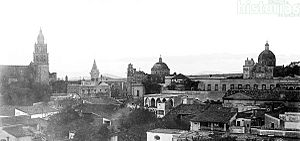
In 1909, a movement against re-election started in Cuernavaca. By the end of the year, Genovevo de la O led rebel actions. Emiliano Zapata took over the movement in the south. He put De la O in charge of Cuernavaca. On May 21, 1911, government troops left Cuernavaca. This left the whole state in rebel hands. Zapata rode into the city with 4,000 troops. They were greeted by crowds. President Francisco I. Madero visited the city in June 1911.
The city later fell to other forces. Zapata began to attack Cuernavaca in May 1914. It fell by August. In January 1915, the Revolutionary government moved to the city. However, Zapata lost control of Cuernavaca in May 1916. He had to go back to fighting as a guerrilla.
The Spanish flu came to Cuernavaca in 1918. Only about 3,000 people survived. By May 1920, the population was 12,799.
Wealthy people from North America and Europe built second homes in Cuernavaca. They took long vacations there. Sometimes, their children made Cuernavaca their permanent home. This created a mix of cultures. For example, Michael van Beuren, a designer, moved to Cuernavaca permanently.
After becoming U.S. Ambassador to Mexico in 1927, Dwight Morrow bought a weekend home in Cuernavaca. His daughter Anne met Charles Lindbergh there. In 1929, Morrow asked Diego Rivera to paint a mural at the Palacio de Cortes. This was to celebrate his daughter's engagement and thank the people of Cuernavaca.
In the 1920s and 1930s, Cuernavaca became a place for vacations and gambling. The Hotel de la Selva became the Casino de la Selva. It attracted famous people like Rita Hayworth. But gambling was stopped in 1934 by Lázaro Cárdenas. He also made the area a Forest Protection Zone. The casino had important artworks, including murals.
In 1936, Malcolm Lowry wrote his short story "Under The Volcano". This inspired his 1947 novel of the same name. The novel describes Cuernavaca and its surroundings in great detail. It mentions the volcanoes Popocatepetl and Iztaccihuatl.
In 1952, Dr. Sergio Méndez Arceo became bishop of Cuernavaca. He was known for supporting human rights.
In 1956, Erich Fromm started a psychoanalysis group in Cuernavaca. He brought new ideas to the field. This attracted many artists and musicians. In the 1960s, the city was a center for new cultural movements.
In 1966, priest Ivan Illich founded a center to teach Spanish to missionaries. This center closed in 1969. But many teachers continued elsewhere. This made Cuernavaca a top place to learn Spanish for foreigners.
More recently, people in Cuernavaca have worked to protect its environment and history. Groups have fought to save cultural sites. The Frente Civico group won an award for protecting the city's heritage.
The earthquake on September 19, 2017, caused damage in Cuernavaca. Four people died. About 180 homes, 11 churches, and 10 other buildings were damaged or destroyed. This included the Cortés Palace and the cathedral.
During the COVID-19 pandemic in Mexico, Cuernavaca had a curfew. Restaurants and bars had to close. The mayor said the city needed a new cemetery. By August 2020, Cuernavaca had over 1,300 confirmed cases and 223 deaths. In January 2021, some vaccine bottles were stolen from a hospital. Hospitals for serious COVID-19 cases reached full capacity.
Palace of Cortés: A Historic Building
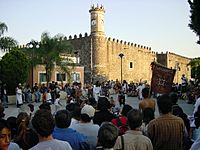
The Palacio de Cortés is a very important building in Cuernavaca. Hernán Cortés built it, and it was finished in 1535. It's one of the oldest European-style buildings in the Americas. It looks like a Renaissance-style mansion. It has arches, battlements, and thick walls. It's said to look like a mansion built by Christopher Columbus's son.
The palace was built on an old pyramid base. This hill overlooked the old city. You can see ancient rock carvings, called petroglyphs, found here and around the city.
For centuries, the building was Cortés's home. Later, it was a warehouse, a jail, and a military base. It was the State Government Palace until 1969. From 1971 to 1973, it was restored. Now, it's the Museo Regional Cuauhnáhuac. This museum tells the history of Morelos State. It has ten rooms with maps, photos, art, and items from different times. It also has murals by Diego Rivera that show Mexican history. Next to the palace, you can find a market selling local crafts.
Morelos and Juárez Gardens: City Squares
The Juárez and Morelos Gardens are in the city center. Both are tree-lined plazas. Between them is the State Government Palace. The Morelos Garden dates from 1908. It has a large stone statue of José María Morelos. The Juárez Garden is older. It has a kiosk that some say was designed by Gustave Eiffel. Unlike most main squares in Mexico, these don't lead to the main cathedral. The cathedral is a few blocks west.
These two gardens are often called the "zócalo". You can often see people dancing here. There are also free concerts. Clowns sometimes perform for children and adults. Locals sell honey, yogurt, traditional candies, and crafts. You can also find street food like corn, snow cones, and fruit smoothies.
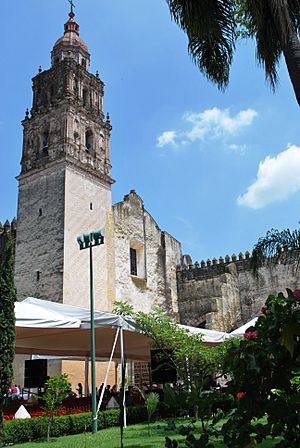
Cuernavaca Cathedral was once a monastery church built in the 1500s. It's on a large open area, called an atrium. This area also has other chapels built at different times. The complex is a few blocks west of the town center.
Cortés built the cathedral to also serve as a fortress. It had cannons on its buttresses. Over time, the church's inside was changed. But in the mid-20th century, it was restored to its original look. Old altars and images were removed. During restoration, murals were found on the walls. They show the story of Philip of Jesus, the first Mexican saint. Now, the church has a modern crucifix and an image of the Assumption of Mary.
After the Reform War in the 1860s, most of the monastery land became private. Only the cathedral and some small chapels remained. The Revolution Garden was once the cathedral's orchard. The cloister, with its observatory, is now the Robert Brady Museum. The church became the Cuernavaca Cathedral in 1891.
Next to the cathedral is the "open chapel" of San José. It's an original building from the 1500s. It has a vault with three arches facing the atrium. Inside, there's an altarpiece from the 1600s.
The main entrance is on Hidalgo Street. You pass two large chapels there. The Tercera Orden chapel is very artistic. It has a sculpted Baroque entrance painted in colors. Inside, there's a later Churrigueresque altar. Another chapel is the Chapel of Nuestra Señora de los Dolores. The bell tower was added in 1713. The cathedral was damaged in the 2017 earthquake but has been fixed.
Other Interesting Churches
- Parish of Nuestra Señora de Guadalupe (El Sagrario) was built by Manuel de la Borda in the 1700s. It has a Baroque front.
- Parish of Los Tres Reyes Magos in Tetela was built by Franciscans in the 1500s. It has a fresco by Marcos Aldaña.
- El Calvario includes two buildings. The smaller one is an open-air chapel from 1538. It has a cross on top. In front is a fountain. The larger building is the church of San Jose, built in 1939.
- The Church of Tepetates was built in the 1500s. It's known for its unique front with two cypress trees. It's dedicated to Jesus of Nazareth.
- Santuario de Tlaltenango: The Temple of San José is said to be the first church built in the Americas (1523). Next to it is the larger Sanctuary of Our Lady of Tlaltenango, built in 1730.
- Parish of St. John the Apostle (Chapultepec) has an image of el Señor de las Batallas.
- Parish of San Luis Obispo (Amatitlan) was built in the 1600s by Franciscans.
- Parish of San Miguel Arcangel (Acapantzingo) was built in the 1700s.
- Church of San Nicolás Tolentino (Ahuatepec) was built in the 1500s. It has a tomb of a revolutionary general.
- Church of San Lorenzo Mártir (Chamilpa) was built in the 1500s.
- Church of El Divino Salvador (Ocotepec) is a Baroque church from the 1500s. During a siege in 1914, its bells were melted for cannonballs.
There are also non-Catholic churches, like the Episcopal Cathedral of San Miguel Arcángel.
Teopanzolco: Ancient Pyramids
Teopanzolco is an old archaeological site east of downtown Cuernavaca. It was an important ceremonial place in the 1400s and 1500s. The site shows Aztec influence. It has a large pyramid base with two shrines, like the Templo Mayor in Tenochtitlan. New findings suggest Teopanzolco is older and might have been a model for the Templo Mayor. Only the stone columns of the shrines remain. The sacred plaza has fourteen monuments. These include a round altar for the wind god Ehécatl. The ruins were found during a siege in 1914.
Centro Cultural Teopanzolco
Next to the pyramids is a Cultural Center. It has been updated with several concert halls. You can sit outside and watch a video mapping show on the pyramid (in Spanish).
Borda Garden: A Royal Retreat
The Borda Garden is near the cathedral. It was originally a house bought by José de la Borda, a mining owner, in the mid-1700s. His son, Manuel de Borda, turned the land into beautiful gardens. He filled them with flowers and fruit trees. The gardens also have fountains and an artificial lake, finished in 1783. Today, it has an art gallery, offices, a restaurant, and an outdoor theater.
In 1865, this was the summer home of Emperor Maximilian I and his wife Carlota. Today, it's a public park. The gardens are kept beautiful. You can take a short boat ride on the lake. The house is now a museum. It has rooms for temporary exhibits and rooms that show what life was like in the 1700s and 1800s.
The Church of Nuestra Señora de Guadalupe is next to the Borda Garden. Manuel de la Borda built it in 1784. It has a Baroque façade and a beautiful cupola. It was Emperor Maximilian's royal chapel. The cupola was damaged in the 2017 earthquake.
Robert Brady Museum: Art from Around the World
The Robert Brady Museum is in the Casa de la Torre building. This building was once part of the monastery. In 1960, American artist Robert Brady bought it. He made it his home and a private museum. It has art and crafts from all over the world. It also has the original Self-Portrait with Monkey by Frida Kahlo. Other artists like Miguel Cobarruvias and Rufino Tamayo are also featured.
The collection includes old furniture, African and Indian crafts, and ancient pieces. The collection is in fourteen rooms of the old house. It looks much like it did when Brady passed away in 1986. He left the house and its contents to the city.
Tlaltenango: A Historic Neighborhood
Tlaltenango used to be a separate town. Now, it's a neighborhood in Cuernavaca. The main attraction is the church area. It has the Church of San José and the Church of Nuestra Señora de los Milagros de Tlaltenango. San José is one of Mexico's oldest churches, built between 1521 and 1523. Later, a vision of the Virgin led to the building of the second church, the Sanctuary of Nuestra Señora de los Milagros, in 1730.
Hacienda Atlacomulco: An Old Sugar Plantation
The Hacienda de San Antonio Atlacomulco is south of Cuernavaca. Hernán Cortés started it as one of Mexico's first sugar plantations. Cortés's family owned it for centuries. In the 1800s, Lucas Alamán modernized it. The hacienda lost most of its land during the Mexican Revolution. Only the main house remains. After much work, it is now a fancy hotel. It can host events and banquets.
Museum of Traditional and Herbal Medicine
South of the city center is Acapantzingo. It used to be a separate town but is now part of the city. Emperor Maximilian I had a large farm here in the 1860s. Today, this farm is home to the Museum of Traditional and Herbal Medicine. The museum offers workshops on using plants for soap, creams, dyes, and more. Outside, there's an ethnic botanical garden. It has 800 plant species. They are organized by how they are used, like for textiles or food.
Children's "Kite" Museum
The Papalote Children's Museum is an interactive museum for kids. It has about thirty exhibits and art experiences. These include a bed of nails, a Vincent van Gogh room, and a bubble factory. Some exhibits are even for children under 3.
Chapultepec Ecological Park: Nature and Fun
The Chapultepec Ecological Park is about four kilometers southeast of Cuernavaca. It has fresh-water springs that form a river. Large trees, called Chapultepec, surround it. It's a public park managed by the State Commission of Water and Environment.
The park has playgrounds. It also has special areas for monkeys, birds, butterflies, crocodiles, and reptiles. You can see aquatic plants and orchids. There's a petting zoo, an environmental museum, a planetarium, a house of terror, a theater, and a tour train. A new design called “Metamorphosis” is being created for the park's entrance. It's inspired by evolution and nature in Morelos.
Chapitel del Calvario: A Church with Spire
The Chapitel del Calvario is a church built in 1532. The word "chapitel" means "spire". The church is named after its two spires. It also has a 14-meter-high dome. It was built in the 1500s. It was the last building you saw when leaving Cuernavaca on the road to Mexico City. In 1772, this church was dedicated to the Virgin of Guadalupe.
El Castillito: The Little Castle Museum
The Museo de Fotografía Antigua, also called El Castillito (the little castle), is near the Chapitel del Calvario. It's a small brick building from the early 1900s. It was built for the park caretaker. Later, it was abandoned. Governor Vicente Estrada Cajigal remodeled it as his home. Since 1986, it has been a small museum. It shows old photographs of Cuernavaca.
Salto de San Antón / St. Anthony Waterfall
The Salto de San Anton is a large ravine with a tall, thin waterfall. It's in the San Anton Analco neighborhood on the west side of Cuernavaca. The waterfall is 36 meters high. Its water comes from a small river. The ravine walls are made of basalt. Plants grow in the cracks of the stone. Stairs and platforms have been built so you can reach the waterfall from the park above. This area is also popular for buying potted plants.
Juan Soriano Museum of Contemporary Art
The Juan Soriano Museum of Contemporary Art is east of downtown. It opened in 2018. It has a collection of 1,200 paintings, sculptures, drawings, and photos. It includes a permanent collection of works by the artist Juan Soriano. The museum was designed by Javier Sanchez.
Ravine of Amanalco Park
Cuernavaca's ravines help control the city's climate. The Ravine of Amanalco was a natural defense line during the Spanish conquest in 1520. Hernán Cortés managed to cross it where the modern "Puente del Diablo" (Devil's Bridge) is now.
The Ravine of Amanalco Park opened in the 1990s. It has a 352-meter long walkway. It starts at the Porfirio Díaz bridge and ends at the arches of an old aqueduct. It's a peaceful walk under thick trees. You'll only hear birds and running water.
You can see the underside of the bridge. It was built in the late 1800s. It connected the city center and the train station.
La Tallera David Alfaro Siqueiros: Art and History
The David Alfaro Siqueiros House and Studio in Cuernavaca was given to the people of Mexico by David Alfaro Siqueiros (1896-1974). He was a famous muralist. In the late 1950s, Siqueiros was working on a mural. He was later imprisoned. When he was released in 1964, he finished the mural. He also built a house and workshop in Cuernavaca. He lived there and created another large mural.
The house/workshop is in Parque Siqueiros. It's recommended to enter from Calle Marte to see the restored murals outside. Entry is free.
Other Museums to Explore
- La Casona Spencer (Spencer House) is a cultural center for the arts. It opened in 2006. The building is old and was given to the city by British artist John Spencer.
- Morelos Museum of Popular Arts shows traditional art from Morelos and Mexico. It has ceramics, wax sculptures, and pottery.
- City Museum / Museo de la Ciudad de Cuernavaca (MuCIC) is in an old colonial building. It has permanent and temporary exhibits. It tells about the city's religious, social, and cultural life. There's also an exhibit about Emiliano Zapata Salazar.
- Museum of Contemporary Indigenous Art has works from 12 different Mexican ethnic groups. You can see textiles, pottery, and wood carvings.
- Museo Güelu is a small modern art museum.
- Science Museum / Museo de Ciencias is a hands-on museum for science. It has exhibits on water and climate change. It offers workshops for children.
- Museum of Sacred Art / Museo de Arte Sacro de Cuernavaca is inside the cathedral. It shows many religious objects.
Parks and Fun Places
- Solidarity Park / Parque Alameda Luis Donaldo Colosio Murrieta has fields for volleyball, basketball, and mini-soccer. It also has a bike path, rollerblading rink, and an artificial lake.
- San Miguel Acapantzingo Park used to be a prison. Now it has the Science Museum, a dancing fountain, and a jogging path.
- Tlatenango Ecological Park has a room for children's movies, art exhibits, tennis courts, and an outdoor gym.
- Chapultepec Ecological Park has a spring, a clear stream, and old trees. It has a butterfly sanctuary, an orchid exhibit, and different animals. There's a house of horror, a planetarium, and a tourist train.
- Melchor Ocampo Garden of Art was opened in 1897. It's a place where natural products and crafts are sold.
- Revolution Park is downtown. It has gyms for basketball and volleyball, a swimming pool, and a chess area.
- Unidad Deportiva Centenario (Centennial Sports Center) has a soccer stadium, baseball field, and gyms.
- El Miraval is a sports complex with a soccer field.
- Parque lineal Ferrocarril de Cuernavaca is a bike path along an old rail line. It's popular for cycling, rollerblading, and jogging.
- La Cascada (the waterfall) water park has a small waterfall, an Olympic swimming pool, and picnic areas.
- Barranca de Chalchihuapan (Chalchihuapan Ravine) has rustic ponds and a river for raising trout. You can choose a fish and have it prepared there.
- El Túnel (the tunnel) is an important source of drinking water. You can take tours.
- Cuernavaca has two private golf courses: Club de Golf Tabachines and Club de Golf de Cuernavaca.
Monuments: Statues and Landmarks
- Morelotes is a large statue of Jose Maria Morelos y Pavon. It's in the Zocalo.
- A statue of Cuauhtemoc, the last Aztec emperor, is at an intersection.
- Paloma de la Paz (Dove of Peace) is a statue at a traffic circle.
- A monument to General Carlos Pacheco Villalobos, the first governor of Morelos, is in front of the Palace of Cortes.
- A monument to Manuel Ávila Camacho, a former president, is at a traffic circle.
- A monument to Vicente Guerrero, a military leader and president, is on Av. Vicente Guerrero.
- A statue of Emiliano Zapata is at a traffic circle.
- A statue of the Niño Artillero, Narciso Mendoza, is at a traffic circle. He was a brave boy who fired a cannon during a siege.
- Libertad de Expression (Freedom of the Press) is a monument to journalists.
- A statue of Alexander von Humboldt is downtown. He gave Cuernavaca its nickname.
- A statue of Benito Juárez is on Juarez Blvd.
- A bust of María Félix, a Mexican actress, is in Plaza Maria Bonita.
- Acueducto de Gualupita is an old aqueduct.
- Porfirio Díaz bridge was built in the 1890s.
- Stampeding Horses, Five Bathing Nymphs, and Diana the Huntress are statues in Colonia Vista Hermosa.
- Many chapels and churches are also considered monuments, like Capilla Culhuacán de los Dolores and Capilla de los Santos Reyes.
- The train station from the late 1800s now hosts a dance studio.
- Cine Morelos is an old theater that now shows art films.
- Puente del Diablo bridge crosses a ravine.
- Calle Rufino Tamayo is named after the artist. Diego Rivera and Rufino Tamayo lived nearby.
- A statue dedicated to women is at a street corner.
- A statue of Blind Justice is in front of the Palacio de Justicia.
Fun Festivals and Dances
The Feria de la Flor (Flower Fair) started in 1965. It's held from May 2 to 12. Flower growers from all over Mexico show their flowers and compete for a prize. The event also has rides, horse competitions, music, and cultural events.
Neighborhood celebrations are common in Cuernavaca. They often honor patron saints. Some examples are:
- May 15: Feast of San Isidro Labrador.
- June 13: Feast of San Antonio, with Aztec dances.
- August 6: Feast of the Savior in Ocotepec, with dances and traditional food.
- August 10: Feast of San Lorenzo in Chamilpa.
- August 15: Festival of the Assumption of Mary in Santa María Ahuacatilán.
- September 8: Festival of Nuestra Señora de los Milagros in Tlaltenango.
Since 1965, Cuernavaca has also had a carnival.
The Huehuechis, a dance group, started in Cuernavaca in 1870. Young people dressed in old clothes and danced in the streets. The name comes from a Nahuatl word for old clothes. This event spread to other towns. It became formally organized in 1871. It's a traditional way to celebrate the days before Lent. The tradition spread to Tepoztlan. There, the dancers changed their clothes and added masks with beards. This new version was called "Chinelos". It became very popular at carnivals in Morelos.
Cuernavaca has been a popular getaway for wealthy people since Aztec times. This continues today. Many artists, thinkers, and film stars have lived here. María Félix, a famous Mexican actress, had a beautiful villa here.
U.S. Ambassador Dwight Morrow had a weekend home in Cuernavaca. He asked artist Diego Rivera to paint murals at the Palacio de Cortes. Today, a restaurant called La India Bonita is in his old house. It's named after a legendary mistress of Emperor Maximilian I. You can also see Rivera murals at the restaurant Casa Rivera. This was once the home of Mexican actor Mario Moreno Cantinflas.
In the 1930s, legal gambling attracted Hollywood stars and mobsters. Cuernavaca is the setting of Malcolm Lowry's novel Under the Volcano. In the 1950s and 1960s, many Hollywood directors and actors came here.
Cuernavaca became home to the CIDOC (Centro Intercultural de Documentación) in 1961. This Catholic center taught priests from other countries. It was founded by Ivan Illich. In the 1960s, the city became a center for new cultural movements.
The trend continues today. Many retirees, diplomats, and business people from all over the world live in Cuernavaca. They have formed groups like the Cuernavaca Newcomers Club. This club helps new residents. Services for foreign residents include English-speaking doctors and foreign media.
The former Shah of Iran, Mohammad Reza Pahlavi, lived in Cuernavaca for a short time in 1979. Princess Maria Beatrice of Savoy, from Italy, lived here from 1971 until 1999.
Cuernavaca has also been a filming location. Parts of the movie Butch Cassidy and the Sundance Kid were filmed nearby. The comedy The In-Laws was also filmed here. In 1984, John Huston filmed Under the Volcano in Cuernavaca.
The Cuernavaca municipality includes 12 towns. These are Acapantzingo, Ahuatepec, Amatitlan, and others. As the main city of Morelos, Cuernavaca governs 142 other communities. The municipality is in the northeast of Morelos State. It borders other municipalities like Huitzilac and Jiutepec. The Cuernavaca Metropolitan Area includes several of these municipalities.
In 2005, only about 3,041 people in the municipality spoke an indigenous language. In 2015, the municipality had 366,321 people. The city of Cuernavaca is in the southern part of the municipality. About 38% of the land is developed for the city and its suburbs.
The municipality is between two mountain ranges. These are the Trans-Mexican Volcanic Belt in the north and the Sierra Madre del Sur in the south. It's in a smaller mountain range called the Sierra del Chichinautzin. The municipality covers 151.2 square kilometers. About 5,668 hectares are used for farming. About 8,227 hectares are for fishing. About 5,400 hectares are developed areas. And 1,390 hectares are forest. The average height is 1,510 meters above sea level. It varies between 1,255 and 2,355 meters. The highest parts are in the east and north.
Rivers and Streams
During the rainy season, rivers form in the ravines. These include Minaltepec, Ajomulco, and Los Caldos. They all join to form the Cuernavaca River. Other rivers form the Río Tembembe.
Other streams are in the gulch of las Canoas and the Tecolote. The Amanalco stream flows into the Río Apatlaco. Springs in Cuernavaca include Los Atzingo and Chapultepec. The municipality is in the Amacuzac River Basin.
Notable Municipal Presidents
Since 1929, the city has had 50 mayors. Some well-known ones include:
- (1997-2000): Sergio Estrada Cajigal Ramírez. He later became governor of Morelos.
- (2003-2006): Adrián Rivera Pérez. He became a federal senator.
- (2006-2009): Jesús Giles Sánchez. He became a federal deputy.
- (2015-2018): Cuauhtémoc Blanco. He resigned to run for governor of Morelos and won in 2018.
Cuernavaca has a tropical savanna climate. Its temperatures are mild because of its altitude. May is the warmest month, with an average of 23.5°C (74.3°F). January is the coolest, with an average of 18.7°C (65.7°F).
The municipality has two different climates. In the north, it's temperate and a bit moist. Rain mostly falls in the summer. This area has pine and holm oak forests. In the south, the climate is warmer with the same rain pattern. This southern area is mostly grassland with some rainforest. The average yearly temperature is 20.9°C (69.6°F). Temperatures rarely go above 34°C (93°F) or below 10°C (50°F).
| Climate data for Cuernavaca (1951–2010) | |||||||||||||
|---|---|---|---|---|---|---|---|---|---|---|---|---|---|
| Month | Jan | Feb | Mar | Apr | May | Jun | Jul | Aug | Sep | Oct | Nov | Dec | Year |
| Record high °C (°F) | 31.5 (88.7) |
37.0 (98.6) |
36.0 (96.8) |
39.5 (103.1) |
37.5 (99.5) |
36.0 (96.8) |
34.0 (93.2) |
33.5 (92.3) |
31.5 (88.7) |
36.0 (96.8) |
31.0 (87.8) |
34.0 (93.2) |
39.5 (103.1) |
| Mean daily maximum °C (°F) | 25.2 (77.4) |
26.5 (79.7) |
28.8 (83.8) |
30.1 (86.2) |
29.7 (85.5) |
27.1 (80.8) |
26.2 (79.2) |
26.1 (79.0) |
25.1 (77.2) |
25.9 (78.6) |
25.8 (78.4) |
25.2 (77.4) |
26.8 (80.2) |
| Daily mean °C (°F) | 18.7 (65.7) |
19.9 (67.8) |
21.9 (71.4) |
23.3 (73.9) |
23.5 (74.3) |
22.0 (71.6) |
21.1 (70.0) |
21.0 (69.8) |
20.4 (68.7) |
20.4 (68.7) |
19.7 (67.5) |
18.9 (66.0) |
20.9 (69.6) |
| Mean daily minimum °C (°F) | 12.2 (54.0) |
13.3 (55.9) |
15.0 (59.0) |
16.6 (61.9) |
17.3 (63.1) |
16.8 (62.2) |
16.0 (60.8) |
15.9 (60.6) |
15.7 (60.3) |
14.9 (58.8) |
13.7 (56.7) |
12.7 (54.9) |
15.0 (59.0) |
| Record low °C (°F) | 3.0 (37.4) |
5.0 (41.0) |
6.5 (43.7) |
10.0 (50.0) |
11.0 (51.8) |
10.0 (50.0) |
11.0 (51.8) |
10.0 (50.0) |
10.0 (50.0) |
9.0 (48.2) |
3.0 (37.4) |
5.0 (41.0) |
3.0 (37.4) |
| Average precipitation mm (inches) | 13.6 (0.54) |
7.2 (0.28) |
5.6 (0.22) |
15.5 (0.61) |
57.7 (2.27) |
250.9 (9.88) |
266.7 (10.50) |
268.1 (10.56) |
256.3 (10.09) |
100.2 (3.94) |
16.7 (0.66) |
5.2 (0.20) |
1,263.7 (49.75) |
| Average precipitation days (≥ 0.1 mm) | 1.3 | 1.3 | 1.3 | 3.3 | 8.6 | 18.8 | 20.7 | 21.0 | 20.0 | 9.7 | 2.4 | 1.1 | 109.5 |
| Average relative humidity (%) | 51 | 47 | 39 | 40 | 48 | 62 | 68 | 67 | 73 | 68 | 60 | 56 | 57 |
| Mean monthly sunshine hours | 277 | 271 | 293 | 276 | 263 | 209 | 239 | 219 | 189 | 237 | 268 | 270 | 3,011 |
| Source 1: Servicio Meteorologico Nacional (humidity 1981–2000) | |||||||||||||
| Source 2: Deutscher Wetterdienst (sun, 1961–1990) | |||||||||||||
Most of Cuernavaca's economy comes from retail trade. This is mainly in and around the city. Farming and fish farming employ the fewest people. The far north of the municipality isn't good for farming. Most farming happens in the southeast. Lower areas are best for fishing and fish farming. Middle elevations are used for both farming and forest products. Higher elevations are mostly forest. Fish farming areas are facing pressure from new housing.
On the edge of Cuernavaca, there are many plant nurseries. They grow and send plants, flowers, and seeds all over the world. Many famous gardens get their flowers from the Cuernavaca region.
There isn't much big industry here. Most businesses are small, like printing, framing, and making clothes. About 28% of the people work in these jobs. Most people (67%) work in retail and service jobs. These jobs depend a lot on tourism.
Local crafts include ceramics and wax products. The wax is from bees and is shaped into fun figures. You can also find clay pots, handmade paper, and painted wooden masks.
Cuernavaca has many private elementary, middle, and high schools. Here are some of the top-performing schools from a 2009 exam:
Top Elementary Schools
- Ingles de Cuernavaca (private)
- Huitzilac (private)
- ABC (private)
- Montessori (private)
- Colegio Mundo Feliz (private)
- Colegio Tehatsi (private)
- Colegio Hamilton of Cuernavaca (private)
- Olinca (private)
- Niños Heroes (public)
- Dorados (private)
Top Middle Schools
- Colegio Tehatsi (private)
- Centro Educativo Cocoyoc (private)
- Dorados (private)
- Colegio Boston (private)
- Nezahuacoyotl (telesecundaria)
- Helen Keller (private)
- Colegio Williams of Cuernavaca (private)
- Miraflores de Cuernavaca (private)
- Martires Agraristas (telesecundaria)
- Olinca de Cuernavaca (private)
High Schools with Bilingual Programs
- Colegio Marymount: Offers programs in English and French.
- Colegio Williams de Cuernavaca: Offers advanced Cambridge University certification.
- Preparatoria de Colegio Boston
- Universidad Tecmilenio
- Tecnologico de Monterrey: Offers two bilingual (English-Spanish) programs.
- Loyola Grupo Educativo de Cuernavaca
Universities in Cuernavaca
- UNAM (National Autonomous University of Mexico) has a campus here.
- Universidad Autonoma del Estado de Morelos (Autonomous University of the State of Morelos) has an exchange program.
- Universidad Mexicana de Educación a Distancia (UMED)
- Friar Luca Paccioli University
- Universidad del Valle de Cuernavaca (UVNIVAC)
- Universidad Interamericana, Campus Cuernavaca
- Universidad Privada del Estado de Morelos (UPEM)
- Universidad Americana de Morelos
- Cuauhnáhuac, Campus Lomas de Cuernavaca (UNIC)
- Universidad Loyola de Cuernavaca
- Centro Universidad Aztlán
Learning Spanish for Foreigners Cuernavaca is well-known for its Spanish language schools. They usually offer intense classes for a few hours daily, starting for one week. Many schools also offer tours and cultural activities. They can often help students find housing.
- Cemanuac Spanish School, Calle San Juan No. 3, Colonia Las Palmas Sur, cemanahuacspanishschool.com
- Escuela de Español para Extranjeros, Colonia Prado
- Kukulcan Educational Spanish Community
- Centro de Lengua Arte E Historia Para Extranjeros
- Universidad Internacional Cuernavaca
- Ideal Spanish Language School
- Spanish Language Institute
- Linguatec Cuernavaca
- Anders Languages
International Connections
Cuernavaca is connected with these cities around the world:
 Minneapolis, Minnesota, USA
Minneapolis, Minnesota, USA New York, New York, USA
New York, New York, USA Denver, Colorado, USA
Denver, Colorado, USA Ōtaki, Chiba, Japan
Ōtaki, Chiba, Japan
The city is about 90 minutes away from Mexico City by car.
Cuernavaca airport is the local commercial airport. It has had flights from airlines like Mexicana and Aeromexico in the past.
See also
 In Spanish: Cuernavaca para niños
In Spanish: Cuernavaca para niños
- Cuernavaca Center for Intercultural Dialogue on Development
- Governors of Morelos
- List of people from Morelos, Mexico




